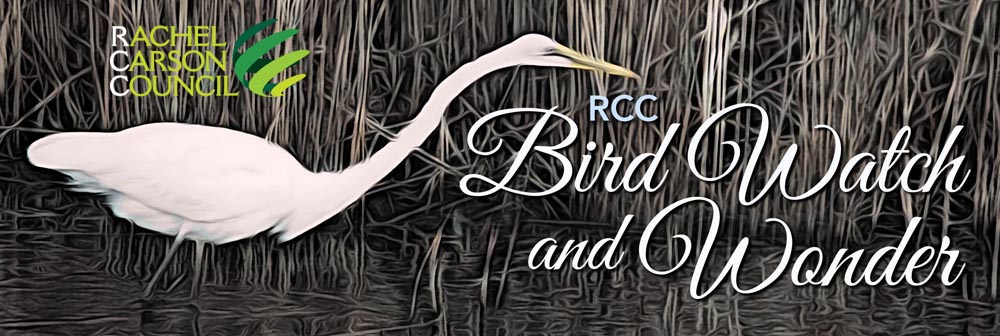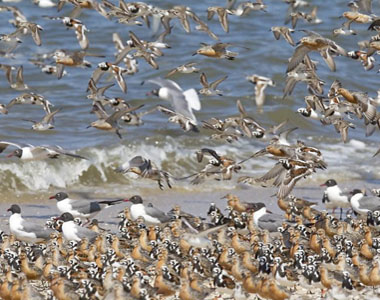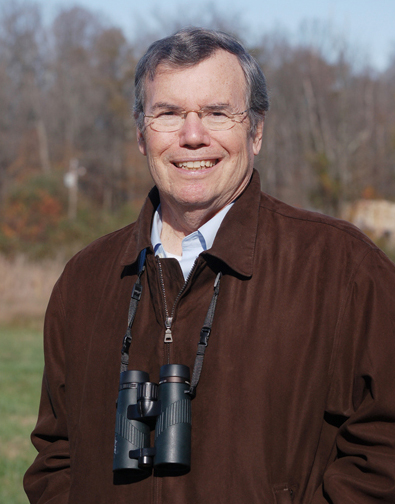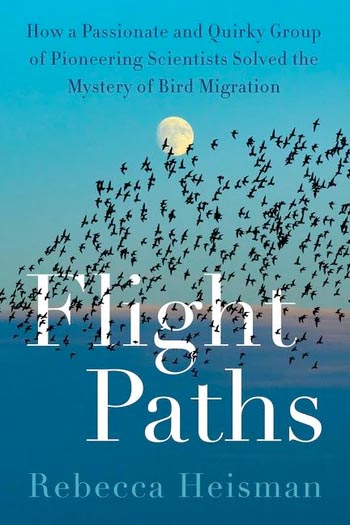 | | |  Birds know more than we think. This month, a Peregrine Falcon laid her fourth egg on the Rachel Carson State Office Building in Pittsburgh. She clearly was thanking Rachel Carson for saving her ancestors by exposing the dangers of DDT. Carson reached huge audiences with Silent Spring, but back when she was writing it, bird watching was definitely confined to a small, educated, White, somewhat nerdy group of naturalists, ornithologists, and people in odd shoes and hats who could pass for eccentric scientists. Birds know more than we think. This month, a Peregrine Falcon laid her fourth egg on the Rachel Carson State Office Building in Pittsburgh. She clearly was thanking Rachel Carson for saving her ancestors by exposing the dangers of DDT. Carson reached huge audiences with Silent Spring, but back when she was writing it, bird watching was definitely confined to a small, educated, White, somewhat nerdy group of naturalists, ornithologists, and people in odd shoes and hats who could pass for eccentric scientists.
Now birding is cool. Rappers, fashionistas, millennials, are all heading outdoors with binoculars (and apps). In this April issue of RCC’s Bird Watch and Wonder, read just how birding became cool and what it is like for today’s young moderns to discover its joys. You’ll also learn how environmentalists and literary folk like RCC National Advisory Council member and MacArthur “genius” Drew Lanham, were drawn to the birds. Lanham writes about his recent sojourn at Walden Pond and how, as a Black youth, he was drawn to Thoreau, poetry, and birding all at the same time. If words and birds are your thing, you will also enjoy Ross Feldner’s latest intriguing contribution as he explores how birds got their unusual names – including the controversial ones. That means you will want to make up your own mind and ponder Christian Cooper’s Op-Ed piece arguing, from a Black birder’s perspective, why the National Audubon Society should drop the name of the renowned enslaver John James Audubon.  As always, you will also find this month’s news, both good and bad, about birds and the ecosystems that support them. In a modern miracle, for instance, a new, small island has formed in the Forsythe National Wildlife Refuge (formerly Brigantine), along the New Jersey coast, allowing endangered horseshoe crabs to flourish and lay their eggs unmolested. This, in turn, has drawn huge flocks of equally endangered, migrating Red Knots to feast upon the eggs. As always, you will also find this month’s news, both good and bad, about birds and the ecosystems that support them. In a modern miracle, for instance, a new, small island has formed in the Forsythe National Wildlife Refuge (formerly Brigantine), along the New Jersey coast, allowing endangered horseshoe crabs to flourish and lay their eggs unmolested. This, in turn, has drawn huge flocks of equally endangered, migrating Red Knots to feast upon the eggs.
But climate change also causes drought and destruction for bird habitats. Noted author and activist, Terry Tempest Williams, a native of Utah, found fame years ago with her first book, Refuge, that chronicled a flooded Great Salt Lake. Now, after a severe drought has dried up most of the huge inland lake, Tempest Williams is “haunted” by the sight of emaciated and dying pelicans whose refuge, Gunnison Island, that had been home for some 20,000 White pelicans, has been destroyed. Being haunted and writing stirring prose, however powerful, is not enough for Tempest Williams, however. She writes, as always, so that you and I will finally take action against climate change and to save the Great Salt Lake. We also offer small steps you can take at home, like how to make sure your windows are not harming birds. Or, you can simply share the world of birds with a child or newcomer. Share with them our “Best of Bird of the Week” or “Best of Momentary Meditations.” Birds, carefully observed, clearly lead us to joy, wonder, imagination, empathy -- to care for others, other people, other species, those far different than ourselves, whatever their unlikely name, or wherever they have migrated from. -Bob Musil | | | | | | | |  Bob Musil is the President & CEO of the Rachel Carson Council and author of Rachel Carson and Her Sisters: Extraordinary Women Who Have Shaped America’s Environment (Rutgers, 2016) and Washington in Spring: A Nature Journal for a Changing Capital (Bartleby, 2016). He is also the editor of the forthcoming annotated edition from Rutgers University Press of Rachel Carson’s Under the Sea-Wind with his Introduction, updated marine science, and historic and contemporary illustrations and photographs. Bob Musil is the President & CEO of the Rachel Carson Council and author of Rachel Carson and Her Sisters: Extraordinary Women Who Have Shaped America’s Environment (Rutgers, 2016) and Washington in Spring: A Nature Journal for a Changing Capital (Bartleby, 2016). He is also the editor of the forthcoming annotated edition from Rutgers University Press of Rachel Carson’s Under the Sea-Wind with his Introduction, updated marine science, and historic and contemporary illustrations and photographs. | | | | | | What’s in a (Bird) Name? In his play Romeo and Juliet, the immortal bard William Shakespeare once posed the question, “What's in a name?” This was a reference to the idea that names are a method to distinguish things or people, but names themselves do not have any worth or meaning. In the bird world names do have meaning, many different meanings. Some refer to visual identity, some to habitat, some to sound, many to people, while some are just baffling and strange. | | | | | | | | A Poet-Ornithologist Walks Walden Pond, From Boise to Concord By RCC National Advisory Council member, Drew Lanham "I first met Thoreau in my junior high English composition and American literature classes. Most of my peers didn’t take to Emerson, Thoreau, and Whitman, but I did. Even if removed from my own life by more than a century, there was this hint of kindred spiritedness, across time and race and place, that appealed to me." | | | | | | | | How Birding Became Cool Rappers, creatives, and fashion brands are all going birdwatching. When did birdwatching become cool — and why didn’t it happen in time to save me from the middle school nickname “bird boy?” Truth is, I was fine with the light teasing I received for my teenage fixation on avifauna. It didn’t stop me from decorating the back corner of our biology classroom with clippings about Pale Male (Manhattan’s celebrity red-tail), or from earning a New York state falconry license at age 12. | | | | | | | | How Birding Became a Hipster Millennial Hobby and What a Birding Trip is Really Like When my friend told me she’d recently gotten into birding, I laughed. “Are you an 80-year old retiree?” “No, it’s a hipster millennial thing now,” she insisted before dragging me with her on a three-day birding trip. It turns out, she wasn’t wrong. According to a recent survey by the U.S. Fish & Wildlife Service, a third of the U.S. population age 16 and up enjoy wildlife watching from observing to feeding and photographing, making it one of the fastest growing hobbies in the U.S. | | | | | | | | | | ‘Aggressive’ Owl Keeps Terrorizing People and Stealing Their Hats at Washington Park An “aggressive and territorial” owl has been prowling around a Washington park, swooping in on people, stealing their hats and scratching them, park officials said. Now people are being warned to stay away from parts of South Whidbey Community Park in Langley, the South Whidbey Parks and Recreation District said in a March 27 Facebook post. | | | | | | | | Meet the Little Brown Bird That Holds a Mirror Up to Humanity Whether we love, hate, or ignore the familiar House Sparrow, its story can teach us about how we relate to the natural world—and each other. Readers who cracked open an 1897 issue of a popular birding magazine called The Osprey found something shocking. Alongside articles about “The Taking of a California Condor’s Egg” and a hunter’s notes on “the table qualities of the Sage Grouse” was a blistering takedown of renowned ornithologist Thomas Brewer by his colleague, Elliott Coues. | | | | | | | | Falcon Lays Fourth Egg on Harrisburg’s Rachel Carson Building It’s a different and most welcome sort of Easter egg. On April 6 the female peregrine falcon at the Rachel Carson State Office Building laid her fourth egg of the year. The first egg this year arrived nearly 2 weeks ago. It takes a month for falcon eggs to hatch. The State Department of Environmental Protection has provided a nest for the falcons on the 15th floor of the building since the first breeding pair showed up in 2000. | | | | | | | | What Offshore Wind Energy Can Teach Us About Seabirds We’re learning more about seabirds from the monitoring studies required for offshore wind energy development. Seabirds spend much of their lives far offshore in the vast ocean, making them hard to study. This gap in knowledge might be starting to change, however, now that we need to understand how offshore wind energy could impact birds before and after construction. | | | | | | | | Federally Protected Bird Makes Her Nest at the Carolina Cup The Killdeer bird called the Steeplechase Race Course home hours before the festivities began. "A citizen was walking the grounds and happened to see a momma bird dragging her wing, making all this noise, which is what a Killdeer bird does when you approach the nest," said Camden Police Lieutenant Penny Lloyd. "She noticed it and then saw the eggs so she called right over there to us and brought us over." | | | | | | | | Newly Formed Island Off the Coast in Brigantine Serves As a Haven For Federally Listed Red Knot A naturally formed island in New Jersey’s Forsythe National Wildlife Refuge has provided a haven for migratory birds. Now, the site is being proposed for federal protection. Red knot birds travel 9,000 miles each year from South America to breed in the Arctic. The shore birds stop at the Delaware Bay to rest and refuel on horseshoe crab eggs. | | | | | |  | Neonic Nation: Is Widespread Pesticide Use Connected to Grassland Bird Declines? Sixty years ago this summer—in June of 1962—the first of a three-part serialization of Rachel Carson’s book Silent Spring was published in The New Yorker. For most Americans, it was the first time any shadow had been cast on what seemed to be miraculously effective insecticides, like DDT. I was three years old, and the book had predictably little effect on me—at the time. But a decade later, in 1972, I was a 13-year-old with a passion for birds who had read Silent Spring. | | | | | | | | | | Birds and Climate Change The results are clear - birds need our help, and they need it now. Every bird species has unique characteristics that enable it to thrive. If climactic conditions of their living environment become too hot or too cold, or too wet or too dry due to changes sparked by climate change, birds may have difficulty adapting quick enough to survive within their natural range. | | | | | | | | Art Around the Corner: ‘Bird Woman’ With 20-foot Wingspan Replaces Roundabout Dragon in St. George From a 100-pound bronze tortoise to a 12-foot-tall bird woman, Art Around the Corner has gone big this year, and you’ll want to stroll downtown to see the new artwork for yourself. On Saturday, Art Around the Corner began its 19th year by installing nearly 30 new sculptures and works of 3D art in Historic Town Square and Main Street, with additional pieces placed at the St. George Regional Hospital. | | | | | | | | How to Prevent Birds From Crashing Into Your Windows There are few things like the sound of a bird striking your home or office window to grab your attention. But what is merely startling to you can kill birds. Bird-window collisions are common and often fatal to wild birds in the U.S., according to Nicholas Lund, advocacy and outreach manager at Maine Audubon. More than one million birds a day die in this country after striking windows. Luckily, there are steps you can take to prevent it from happening in the first place. | | | | | | | | I Am Haunted by What I Have Seen at Great Salt Lake From a distance, it is hard to tell whether the three figures walking the salt playa are human, bird or some other animal. Through binoculars, I see they are pelicans, juveniles, gaunt and emaciated without water or food. In feathered robes, they walk with the focus of fasting monks toward enlightenment or death. This was not a dream or a nightmare, but the first time I realized Great Salt Lake was in danger of disappearing. It was the fall of 2016. | | | | | | | | Opinion: Why the National Audubon Society Must Change Its Name John James Audubon, famed as a naturalist and for his colorful and dramatic paintings of North American birds, had been dead for half a century in 1905 when his name was plucked from history to headline what would become the nation’s leading bird conservation organization. More recently, his less-illustrious past as an unrepentant enslaver, defiler of Indigenous gravesites and all-around racist has become more widely known. | | | | | | | | Photos Show Bird of Prey Making Staten Island Comeback at Freshkills Park Throughout the middle of the 20th century, the osprey, a bird of prey with a wingspan nearing six feet, was rapidly declining in numbers. Pesticides, namely dichlorodiphenyltrichloroethane, or DDT, made its way into the birds’ food and caused fertility to decrease. Ospreys’ eggs had shells so thin they would crumble under the weight of their parents. | | | | | | | | Glacier Bridge Replacement Has Provisions For Bird Protections Glacier National Park will start construction on a new North Lake McDonald Road bridge over McDonald Creek this month. The clear span bridge will replace a 57-year-old single-lane wooden bridge that has a 15-ton weight limit on it. Firefighting and other services in the area are a strong part of the reason for the bridge replacement, the Park noted in 2022 documents. | | | | | | | | Black Excellence in Birding Join the Academy of Natural Sciences for Black Excellence in Birding, our second annual black-tie Black Birders Week event. Meet some of the country’s most well-known Black birders, go behind the scenes of the Academy to interact with our world-class Ornithology Collection, join the panel discussion on Black women in birding and meet local poets and artists as they share their expressions throughout the night. Tweet an invite to a fellow bird lover, fluff up your plumage for a feathery date night or simply sip cocktails and savor delicious appetizers as you enjoy good conversation with fellow Black birders. | | | | | | | | | | | | Killdeer First described in 1758 by Carl Linnaeus in his Systema Naturae, the killdeer's common name comes from its often-heard call. These long-legged birds are the largest and most familiar member of the ringed plover family. Although it’s classified as a shorebird, the Killdeer typically makes its summer home on golf courses, lawns, fields and even parking lots. Killdeer are ground nesters and the male will make the nest by scraping the ground into a rough bowl shape with his feet. | | | | | | | | Rachel’s Gift Rachel Carson blew her scientific whistle on the uncontrolled use of pesticides. Carson persevered in the face of relentless personal and professional attacks by industrial and political leaders. Her research, writing, and personal witness gave birth to the modern environmental movement. Each year the return of the robins, once threatened by pesticidal extinction, is a sign of the power of one courageous voice. | | | | | | | | Flight Paths: How a Passionate and Quirky Group of
Pioneering Scientists Solved the Mystery of Bird Migration  The captivating, little-known true story of a group of scientists and the methods and technology they developed to uncover the secrets of avian migration. The captivating, little-known true story of a group of scientists and the methods and technology they developed to uncover the secrets of avian migration.
For the past century, scientists and naturalists have been steadily unravelling the secrets of bird migration. How and why birds navigate the skies, traveling from continent to continent—flying thousands of miles across the earth each fall and spring—has continually fascinated the human imagination, but only recently have we been able to fully understand these amazing journeys. Although we know much more than ever before, even the most enthusiastic birdwatcher may not know how we got here, the ways that the full breadth of scientific disciplines have come together to reveal these annual avian travels.
Flight Paths is the never-before-told story of how a group of migration-obsessed scientists in the twentieth and twenty-first centuries engaged nearly every branch of science to understand bird migration—from where and when they take off to their flight paths and behaviors, their destinations and the challenges they encounter getting there. Uniting curious minds from across generations, continents, and disciplines, bird enthusiast and science writer Rebecca Heisman traces the development of each technique used for tracking migratory birds, from the first attempts to mark individual birds to the cutting-edge technology that lets ornithologists trace where a bird has been, based on unique DNA markers. Along the way, she touches on the biggest technological breakthroughs of modern science and reveals the almost-forgotten stories of the scientists who harnessed these inventions in service of furthering our understanding of nature (and their personal obsession with birds). Read more | | | | | | The April 2023 issue of Bird Watch and Wonder was produced by Ross Feldner. | | | | | |  The Rachel Carson Council Depends on Tax-deductible Gifts From Concerned Individuals Like You. Please Help If You can. The Rachel Carson Council Depends on Tax-deductible Gifts From Concerned Individuals Like You. Please Help If You can. | | | |  Sign Up Here to Receive the RCC E-News and Other RCC Newsletters, Information and Alerts. Sign Up Here to Receive the RCC E-News and Other RCC Newsletters, Information and Alerts. | | | | | | | | | | | |